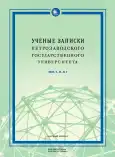METAPHORICAL REPRESENTATION OF IDENTITY IN THE HEADLINES OF ENGLISH-LANGUAGE MEDIA DISCOURSE
- 作者: Mosyagina M.S.1
-
隶属关系:
- Ogarev National Research Mordovia State University
- 期: 卷 47, 编号 1 (2025)
- 页面: 73-79
- 栏目: NATIONAL LANGUAGES OF FOREIGN COUNTRIES
- URL: https://journal-vniispk.ru/2542-1077/article/view/294552
- DOI: https://doi.org/10.15393/uchz.art.2025.1131
- ID: 294552
如何引用文章
全文:
详细
This study analyses the metaphorical representation of identity in the headlines of English-languagemedia discourse, with particular emphasis on metaphorical models with the target domain “IDENTITY”. The relevanceof the topic is driven by the growing interest in studying media as a powerful tool for shaping public consciousness andconstructing socially signifi cant concepts, such as identity. The aim of the research is to identify and systematize themetaphorical models used to represent identity in the headlines of English-language media. Cognitive analysis and linguisticinterpretation of media texts are employed in this study. The research corpus includes 47 headlines from leadingEnglish-language publications (The Guardian and The Independent), selected based on their popularity and infl uence.The fi ndings of the study show that identity is often metaphorically represented through images of a mask, journey, loss,building, and territory, refl ecting the dynamic and multi-layered nature of this concept in media discourse. The mainconclusions are that metaphors play a key role in shaping readers’ perception of identity and that media discourse actively uses these metaphorical models to manipulate public opinion. This study makes a contribution to media discourse linguistics and cognitive linguistics, deepening the understanding of the role of metaphor in contemporary media space.
作者简介
M. Mosyagina
Ogarev National Research Mordovia State University
编辑信件的主要联系方式.
Email: mmashamos@yandex.ru
Cand. Sc. (Philology)
参考
- Budanova, A. A. Metaphor as a means of conceptualizing problematic interpersonal relations in modern English-speaking culture. Ethnopsycholinguistics. 2021; 1(4): 46–64. doi: 10.31249/epl/2021.01.03 (In Russ.)
- Dubrovskaya, V. V., Kabanova, I. N., Romashkina, T. S. Metaphoric models representing the LOVE concept in the English and Spanish song discourse. Philology. Theory & Practice. 2023; 16(8): 2577–2582. doi: 10.30853/phil20230404 (In Russ.)
- Kozlova, L. A. The national-cultural specificity of metaphor and the means of its manifestation in the text. Philology & Human. 2015; 1: 36–46. (In Russ.)
- Malagin, D. V., Kurbanov, I. A. Metaphorical representation of the image of US president Joe Biden in the English-language political media discourse. Vestnik of Northern (Arctic) Federal University. Series “Humanitarian and Social Sciences.” 2023; 23(6): 55–65. doi: 10.37482/2687-1505-V305 (In Russ.)
- Berger, A. A. Media and communication research methods: An introduction to qualitative and quantitative approaches. SAGE Publications, Inc., 2020. 488 p.
- Bowdle, B. F., Gentner, D. The career of metaphor. Psychological Review. 2005; 112(1): 193–216. doi: 10.1037/0033-295x.112.1.193
- Carston, R. Metaphor and the literal/nonliteral distinction. Cambridge Handbook of Pragmatics. Cambridge, 2012. P. 469–492. doi: 10.1017/CBO9781139022453.025
- Fortner, R. S., Fackler, P. M. The Handbook of Media and Mass Communication Theory. John Wiley & Sons, Inc., 2014. 1008 p.
- Gibbs, R. W. The Cambridge Handbook of Metaphor and Thought. Cambridge, 2008. 550 p. doi: 10.1017/CBO9780511816802
- Glucksberg, S. Beyond literal meanings: The psychology of allusion. Psychological Science. 1991; 2: 146–152. doi: 10.1111/j.1467-9280.1991.tb00122.x
- Joseph, R., Liu, T., Ng, A. B., See, S., Rai, S. NewsMet: A ‘do it all’ dataset of contemporary metaphors in news headlines. Findings of the Association for Computational Linguistics: EACL 2023. Stroudsburg, 2023. P. 10090–10104. doi: 10.18653/v1/2023.findings-acl.641
- Kövecses, Z. Metaphor and Emotion: Language, Culture, and Body in Human Feeling. Cambridge, 2000. 242 p.
- Lakoff, G., Johnson, M. Metaphors We Live By. Chicago, 1980. 256 p. doi: 10.7208/chicago/9780226470993.001.0001
- Mousoulidou, M., Taxitari, L., Christodoulou, A. Social media news headlines and their influence on well-being: Emotional states, emotion regulation, and resilience. European Journal of Investigation in Health, Psychology and Education. 2024; 14(1): 1647–1665. doi: 10.3390/ejihpe14060109
- Semino, E. Metaphor in Discourse. Cambridge, 2008. 244 p.
- Steen, G. J. The contemporary theory of metaphor – now new and improved! Review of Cognitive Linguistics (published under the auspices of the Spanish Cognitive Linguistics Association). 2011; 9(1): 26–64. doi: 10.1075/rcl.9.1.03ste
- Van Dijk, T. A. Discourse, ideology and context. Folia Linguistica. 2006; 35(1-2): 11–40. doi: 10.1515/flin.2001.35.1-2.11
补充文件








